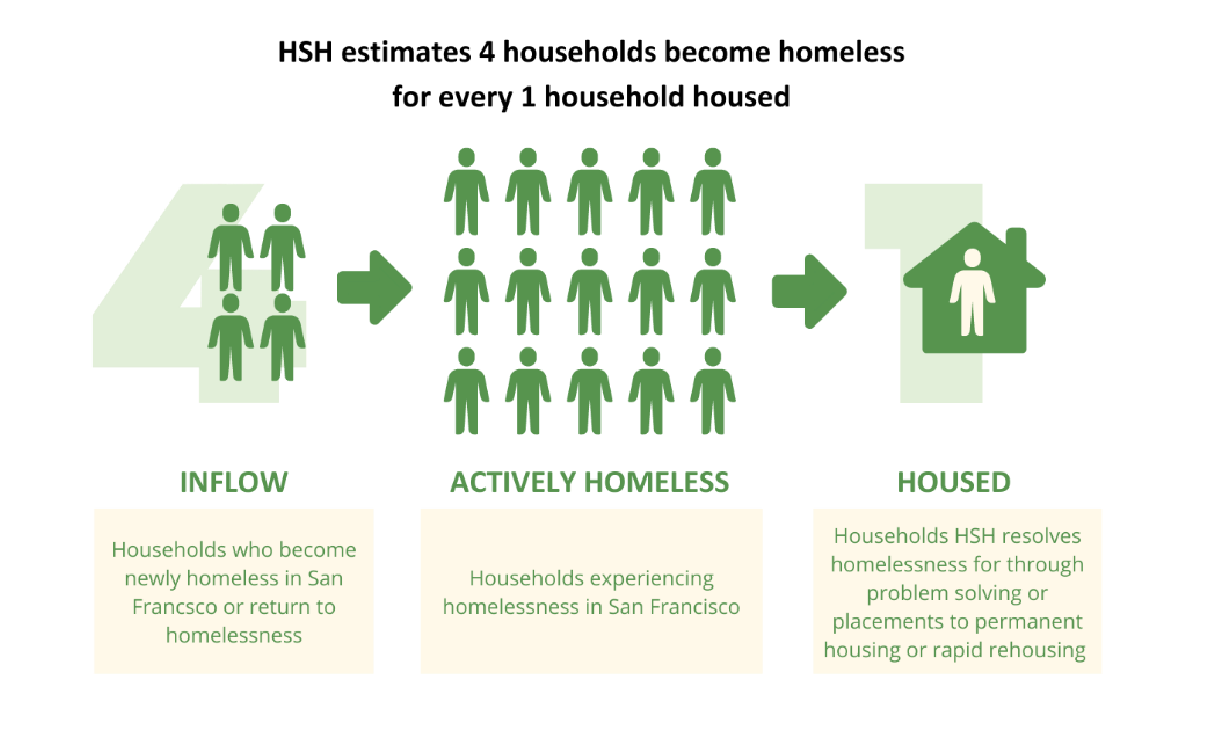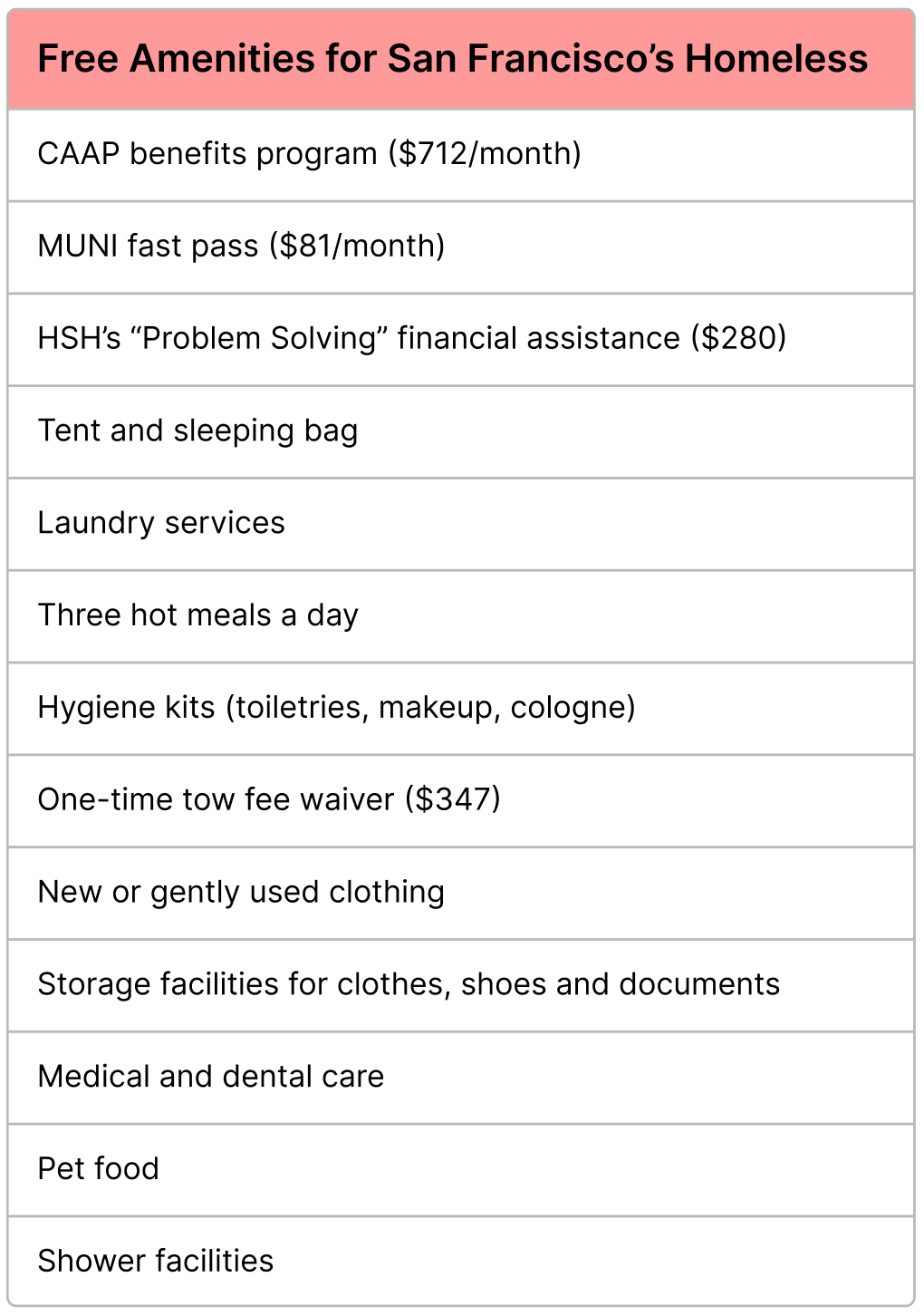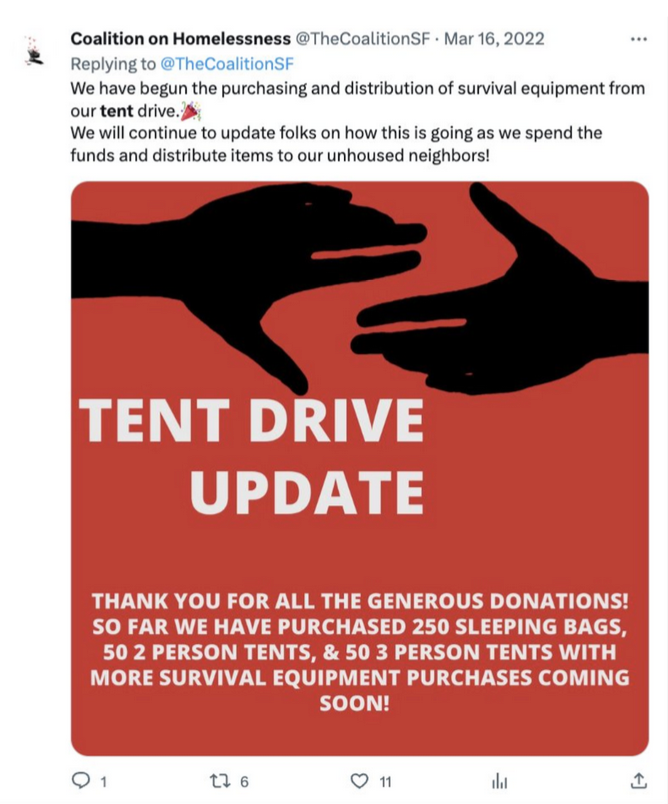San Francisco's Homeless Ticking Time BombAug 17
the majority of the city's homelessness budget goes to keeping people in no-contingency housing units, permanently. what happens when the city can't pay the bill?
Sanjana FriedmanSubscribe to Dolores Park
It happens like this: In downtown San Francisco, a woman pushes a stroller down the street, stopping at each tent she passes and handing out two plastic bags from the pile in the stroller seat: one with foil, lighters, pipes, tourniquets, needles and syringes, the other with Narcan nasal spray and an instruction manual. In a few hours, some of the people she has met may be dead, but she will be back, if not tomorrow then the next day, to hand out more supplies to those who come to replace the dead.
Tent-to-tent drug paraphernalia delivery is just one of dozens of services San Francisco’s local government offers, either directly through city programs or indirectly through city-funded nonprofits, to “support” the roughly 8,000 people who sleep on its streets on any given night. Others include monthly cash payments of up to $712, prepaid grocery cards, subsidized vet care, and free public transit cards.
Taken together, these kinds of services help explain why the city’s homeless crisis continues to worsen despite dramatically increased public spending. The city’s Department of Homelessness and Supportive Housing estimates that for each person it places in public housing, another four enter its system. And though activists often claim these new entrants are long-term local residents pushed onto the streets by real-estate speculation and unaffordable rent, our analysis has found they are overwhelmingly from out of town. Add to this the data showing that a majority of those living on the streets struggle with substance abuse and the takeaway is clear: San Francisco doesn’t have a homeless problem, it has a drug tourism problem.

From the Department of Homelessness and Supportive Housing's 2022 "Point-in-Time" count.
This truth is understood by most longtime city observers. But to understand exactly why San Francisco is such a magnet for drug tourists, let's catalog the various “perks” the city offers those who live on its streets. We can divide these perks into two categories: those that draw people to the city and those that keep them here. The former includes benefits that are known to outsiders (cheap drugs, permissive anti-theft laws, public camping), while the latter includes benefits mainly accessed by transplants once they are familiar with all the services that the local government provides. Together, these perks afford San Francisco the grim distinction of being one of the most attractive cities in the country for those who, in the throes of addiction, want to do drugs until they die.
Most drug tourists who come to live on the streets of San Francisco are drawn here for benefits they’ve learned of through word-of-mouth: The drugs are cheap, theft often goes unprosecuted, and cops generally leave you alone.
The price of fentanyl, the drug of choice for many on the streets, is significantly cheaper here than in cities like Los Angeles, Sacramento, Philadelphia, and New York, as an analysis of Drug Enforcement Agency data by the San Francisco Standard recently revealed. In Los Angeles, an ounce of fentanyl sells for between $650 and $1,000, depending on its potency — but in San Francisco, it goes for between $150 and $550. Though this discrepancy may be partially due to the fact that much of the fentanyl on San Francisco streets is low-purity, it also reflects the saturation of the local drug market, which is teeming with addicts drawn to the city by rumors of cheap drugs and the dealers who have come to serve them.
To finance their habits, many addicts serially shoplift (“boost”) from local retail stores and sell these stolen goods to “fences” — middlemen who resell the goods in street markets or to wholesalers. They face few obstacles to committing these crimes: low-level shoplifting was effectively decriminalized in San Francisco in 2014, when California voters passed Prop 47, which downgraded theft of goods worth up to $950 from a felony to a misdemeanor. Though Prop 47 still nominally permits penalties of jail time and fines for such crimes, under former District Attorney Chesa Boudin, prosecution of shoplifting declined sharply — even today, current District Attorney Brooke Jenkins has cited the “culture of tolerance” behind unpunished retail theft in the city. These stolen goods, though sometimes sold on street corners, are often resold to wholesalers who repackage and sell them online — an operation that moves at least $20 million in product each year. As Leighton Woodhouse writes, “San Francisco’s addiction crisis provides the larceny industry with a permanent low-wage workforce.”
San Francisco is also one of the best places in the country to pitch a tent on the sidewalk, due mainly to activist nonprofits like the Coalition on Homelessness, which sue the city whenever it attempts to systematically clear encampments. Most recently, the coalition won a preliminary injunction in federal appeals court that prevents the city from clearing sidewalk tents unless they can prove the tent occupant is “voluntarily homeless” – having explicitly refused an offer of shelter. The injunction still gives the city some leeway to clear sidewalk tents, which are illegal under a number of laws, but officials often let them fester. In this, they are likely motivated by a desire to avoid the complaints that the coalition helps homeless people file in small-claims court whenever the city clears their tents.
In just three months last year, the city received over 100 of these complaints, each of which sought $10,000 for a range of damages, including property loss and “emotional damages.” Between 2020 and 2023, the city spent over $132,000 on 24 such complaints, paying each homeless plaintiff an average of $5,500 to settle. Taken together, these factors make San Francisco an excellent choice for someone who plans to live indefinitely on city sidewalks while doing drugs.
Subscribe to Dolores Park
Once drug tourists settle here, they may be surprised to learn the city has a vast network of services designed to facilitate their lifestyles indefinitely. This network provides, among other things, generous monthly welfare payments (which only became conditioned on proof of sobriety this month), prepaid grocery cards, free drug paraphernalia, free vet services, and much more.
Homeless people in San Francisco can potentially access up to $712 a month in cash payments through the city’s County Adult Assistance Program (CAAP). State law requires all California counties to provide some form of these payments, known as “general assistance,” to poor residents, though San Francisco’s program is considerably more generous than those of neighboring counties. For example, Alameda and Santa Clara counties offer single people maximum cash grants of around $340 a month.

To qualify for these benefits, which in addition to monthly cash payments include free MUNI fast passes, applicants must prove, through a series of interviews with city social workers, that they have been in San Francisco for at least 15 days and make less than $712 a month after taxes. And though the “Care not Cash” legislation that passed in 2002 nominally made homeless applicants only eligible for monthly payments equal to the maximum CAAP amount minus “any in-kind value of shelter, utilities and food offered to the client,” according to the CAAP eligibility manual, administrative loopholes allow homeless applicants access to maximum cash value CAAP grants known as “Shelter Cash Outs” if they are either paroled sex offenders (and thus ineligible to stay at city shelters) or if there are no shelter spaces available. And given that there is a Shelter Reservation Waitlist, all current CAAP applicants would theoretically qualify by default for a full $712-a-month Shelter Cash Out grant.
In addition to the grant money, newly arrived out-of-towners also qualify for financial assistance through Department of Homelessness and Supportive Housing’s “Problem Solving” program, which covers deposits as well as first and last month’s rent for local housing, ongoing rental assistance after move-in, and furniture costs, among other expenses. To be eligible for this assistance, applicants need only prove they are “experiencing homelessness in San Francisco,” a definition that relies on simply demonstrating a “connection to San Francisco” (which, per HSH, means having spent just one of the last seven nights in the city).
New arrivals also can get a tent from the Coalition on Homelessness, which regularly raises money to buy and distribute tents to homeless people who camp on the city’s streets. They could also consult the coalition’s “Homelessness Service Guide,” a convenient master doc cataloging where “unhoused neighbors” can access free food, shelter, hygiene kits, medical care, curbside pet-food pickup, storage facilities, legal counsel, and more. The coalition's executive director, Jennifer Friedenbach, helps oversee the disbursement of almost $300 million in public funds earmarked for homeless-related services in the city.

Elsewhere, nonprofits like the San Francisco AIDS Foundation and GLIDE offer free syringes, foil, tourniquets, and naloxone seven days a week on a drop-in basis. Both of these programs are funded by generous city grants — the San Francisco AIDS Foundation received over $20 million in public funds in 2021, while GLIDE got around $2.7 million, according to their respective tax returns. And for those not willing or able to get to the nonprofits’ offices, GLIDE even sends its employees to deliver drug-use supplies tent-to-tent.
And though technically illegal under federal law, rogue nonprofit workers also periodically set up “safe consumption sites” around San Francisco where addicts can consume drugs like fentanyl and meth under supervision and with free supplies. Convenience, as ever, is king. “We have stuff for people who inject drugs as well as smoke drugs, so have a couple of different sizes of needles for people to choose from," one nonprofit employee working at such a site told ABC7 last year.
Faced with this ecosystem of supportive services, permissive drug use, public camping, and theft laws — all of which seem designed to maximally enable the lifestyles of drug tourists amid a historic overdose crisis — the obvious question to ask is, simply: Why?
Why does San Francisco fund services that deliver instruments of death directly to tent doors? Why does the Coalition on Homelessness fight tooth-and-nail to protect people’s “right” to do drugs on city streets until they die? Though some of the nonprofit workers and city employees involved in pushing these services are doubtlessly motivated by the sincere belief that what they are doing is lifesaving work, others are less naive. “Downtown is for Drug Users,” says the Drug User Liberation Collective, an organization that recently put posters up around town protesting Mayor London Breed’s promise to crack down on open drug use.
In other words, addiction — like race, ethnicity, or sex — is an identity category worthy of protection, even if this "protection" is cruel and inhumane. And if drug users need cheap drugs, lax anti-camping laws, and low-stakes theft opportunities to fuel their habits, then who are we to not oblige? Downtown is for drug users, after all.
– Sanjana Friedman
Subscribe to Dolores Park
0 free articles left